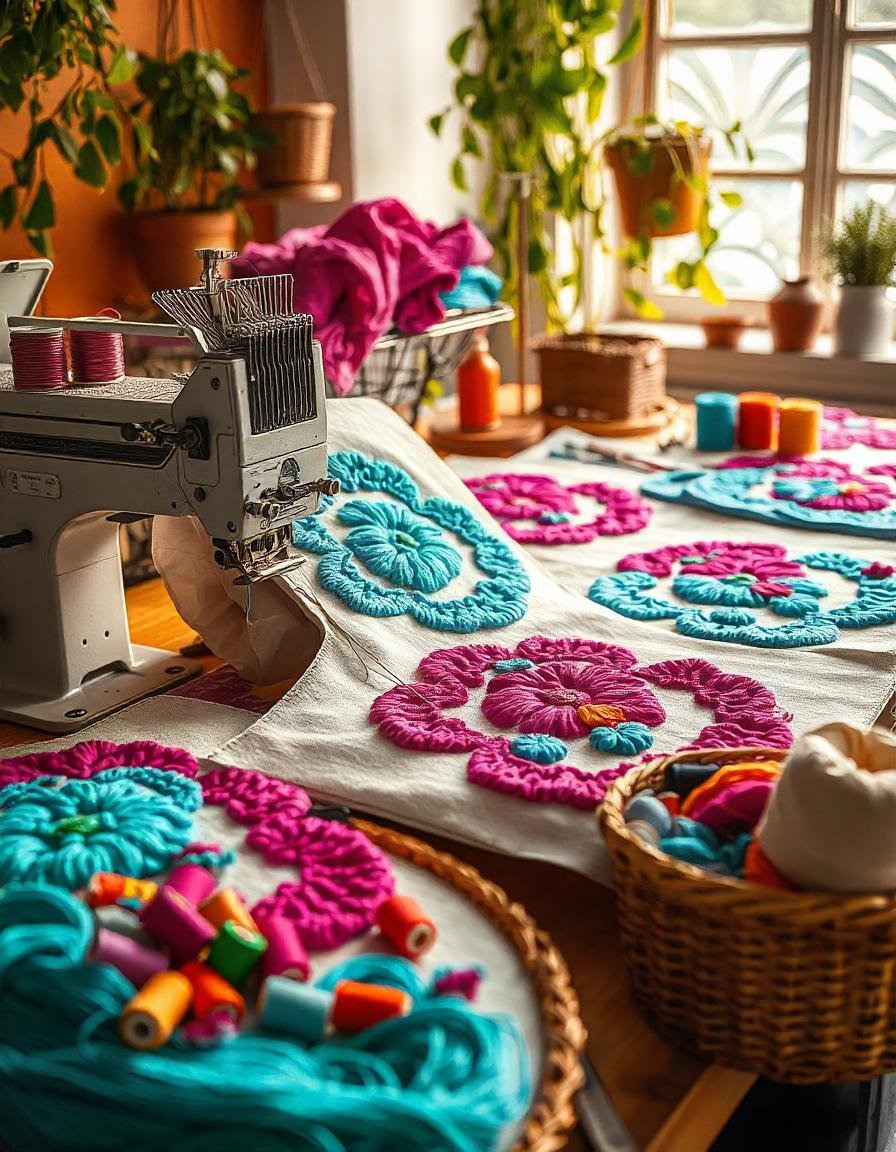3D puff digitizing can transform your embroidery projects by adding dimension and visual appeal. This technique uses foam to create a striking, raised effect that enhances bold logos and texts. You’ll need to take into account design elements, like using simple shapes and high-contrast colors, to guarantee the best results. Incorporating the right materials, such as heavyweight stabilizers and smooth fabrics, is essential. By mastering specific techniques like tack-down stitches and adjusting stitch density, you can achieve a clean, impactful finish. If you explore further, you’ll discover even more tips to perfect your 3D puff embroidery skills.
Understanding 3D Puff Embroidery
Understanding 3D puff embroidery begins with recognizing how foam creates a striking, raised effect that enhances your designs. This technique involves placing foam beneath the stitches, which are then cut to match the intended shape, resulting in a vibrant, three-dimensional look.
When you’re exploring foam digitizing, consider the thickness of the foam, typically ranging from 1.5mm to 3mm, as it greatly impacts the height and visibility of your design.
To succeed in puff embroidery, choosing the right embroidery stabilizers is essential. Heavyweight cutaway stabilizers work best for wearable items, ensuring the foam’s weight is supported and the overall design remains intact.
This combination of elements makes 3D puff embroidery ideal for bold logos and text on various products.
Design Considerations for Puff Embroidery
When you’re designing for puff embroidery, focus on bold, simple elements with large color areas to maximize the 3D effect.
Also, consider the fabric type, as it can greatly impact how well the puff appears.
Design Characteristics for Effectiveness
To create effective 3D puff embroidery, choose bold and simple designs with large solid color areas that guarantee the raised effect stands out. Confirm your text is large enough for legibility; a minimum height is essential for effectiveness. Good color selection is also critical—contrast your design with the foam color to enhance visibility. Make certain your design size fits the embroidery area; larger designs may lose impact if they’re disproportionate.
| Design Characteristic | Importance |
|---|---|
| Bold & Simple | Enhances visibility |
| Large Text | Maintains legibility |
| High Contrast Colors | Improves clarity |
| Proper Size | Confirms effectiveness |
| Solid Color Areas | Highlights puff effect |
Fabric Type Considerations
Choosing the right fabric is vital for achieving the best results in 3D puff embroidery, as it directly influences the final appearance and durability of your design.
Opt for smooth materials like twill or cotton, which work better than textured fabrics. Heavier fabrics support the foam effectively, while lighter fabrics may need stabilizers to prevent distortion.
Be cautious with stretchy fabrics; adapt your designs to guarantee the foam maintains its shape post-wash. Additionally, make certain the fabric color contrasts with the foam color to enhance the visibility of the 3D effect.
Properly hooping the fabric is critical, as any shifting during the embroidery process can lead to misalignment, compromising your puffed design’s overall impact.
Materials for 3D Foam Embroidery
Selecting the right materials for 3D foam embroidery can greatly enhance the design’s depth and visual appeal.
Start with high-quality foam, choosing thicknesses like 1.5mm, 2mm, or 3mm, as they directly impact the height and overall effect.
Opt for foam colors that contrast well with your embroidery thread to guarantee visibility.
For stabilizers, heavyweight cutaway stabilizers work best for wearable items, while tear-away types are suitable for products that aren’t washed often.
Don’t forget to use an adhesive spray to secure the foam to your fabric during stitching.
This helps maintain stability and guarantees accurate placement, resulting in a crisp and defined 3D look that stands out beautifully.
Techniques for Successful Puff Embroidery
After you’ve prepared your materials, mastering the techniques for successful puff embroidery will assure your designs achieve that striking 3D effect.
Start by running regular embroidered elements before applying the puffy foam. Use tack-down stitches to secure the foam in designated areas, and consider using adhesive spray for added stability.
Set your stitch density to 50-40% with a spacing of 0.16 mm to assure clean cutting. Avoid underlays, as they compress the foam and diminish the 3D effect; tack-down stitches alone provide enough support.
Regularly evaluate and adjust your thread tension to prevent looping, assuring crisp edges and a well-defined puff.
Applications and Benefits of Puff Embroidery
Puff embroidery offers a unique way to enhance the aesthetic appeal of various products, from caps and jackets to bags and towels.
Its applications are vast, making it a popular choice for promotional items like hats, where raised logos boost brand visibility.
On jackets and sweatshirts, puff embroidery adds visual depth, creating a more dynamic look compared to flat embroidery.
You’ll find that this technique also stands out on bags and totes, helping your products catch attention in a crowded market.
When applied to towels and blankets, it introduces unique textures that elevate perceived value.
The versatility of puff embroidery extends to customizable patches and badges, broadening its applications and benefits across many items.
Expert Insights on 3D Foam Embroidery
When you’re tackling 3D foam embroidery, understanding effective digitizing techniques is key to your success.
Choosing the right foam is just as essential, as it can make or break the final look of your project.
You’ll also face unique challenges, so let’s explore how to navigate these aspects for stunning results.
Techniques for Effective Digitizing
Effective digitizing in 3D foam embroidery hinges on precise stitch spacing and density adjustments to achieve a clean, defined finish.
You should aim for a stitch spacing of 0.16 mm, which facilitates easy foam removal and proper cutting during the stitching process. For tack down stitches, digitize them as a single run stitch with a 4 mm length to maintain foam integrity and height.
Avoid using underlays, as they can compress the foam and detract from the desired 3D effect. Additionally, adjust the density values to 50-40% to guarantee a neat foam finish without excess stitching.
Importance of Foam Selection
Choosing the right foam is vital for achieving vibrant, durable, and visually striking 3D embroidery designs. Your foam selection directly influences the final look and longevity of your work.
Opt for embroidery foam over craft foam, as it withstands washing and wear. Pay attention to the thickness of the foam; typically ranging from 1.5mm to 3mm, thicker options create a more pronounced elevation, enhancing your design’s depth.
Additionally, selecting the right foam color is important—choose shades that contrast with your embroidery thread to make the design pop.
Challenges in Foam Applications
Mastering 3D foam embroidery presents several challenges, particularly in achieving the right needle penetration angle to avoid issues like looping and uneven edges.
You’ll need to pay close attention to your digitizing process, especially with thread tension and density settings, ideally between 50-40% for a clean finish.
Properly placed tack-down stitches are essential; set them centrally with a stitch length of 4 mm to minimize foam compression while preserving the foam’s shape.
Additionally, adjusting your underlay distance is important to prevent excessive compression, which can detract from the foam’s three-dimensional quality.
Conclusion
As you immerse yourself in the world of 3D puff embroidery, you’ll discover endless possibilities that can elevate your designs.
Imagine the vibrant textures and eye-catching dimensions that can make your work stand out.
But wait—what if you could master the techniques and materials to truly transform your projects? The journey is just beginning.
With the right insights and practice, you’ll find yourself creating stunning pieces that leave a lasting impression.
Are you ready to take the leap?
Frequently Asked Questions
What Is 3D Puff Embroidery Digitizing?
3D puff embroidery digitizing creates a raised effect by placing foam under stitches. You’ll use satin fill and specific techniques to guarantee the foam stays intact, resulting in bold, eye-catching designs that stand out beautifully.
How to Make 3D Puff Embroidery?
To make 3D puff embroidery, create a bold design, select the right foam thickness, use appropriate stabilizers, digitize with proper settings, and secure the foam with adhesive spray before stitching. Your design will pop!
What Is Puff or 3D Embroidery?
Puff or 3D embroidery gives your designs a raised, three-dimensional look. Placing foam under stitches enhances the visual impact, making logos and text on apparel more eye-catching and distinct.
How to Digitize a Design for Embroidery?
To digitize a design for embroidery, create a bold design with large areas, set stitch spacing to 0.16 mm, use 4 mm tack-down stitches, and adjust the density to 50-40% for a clean look


